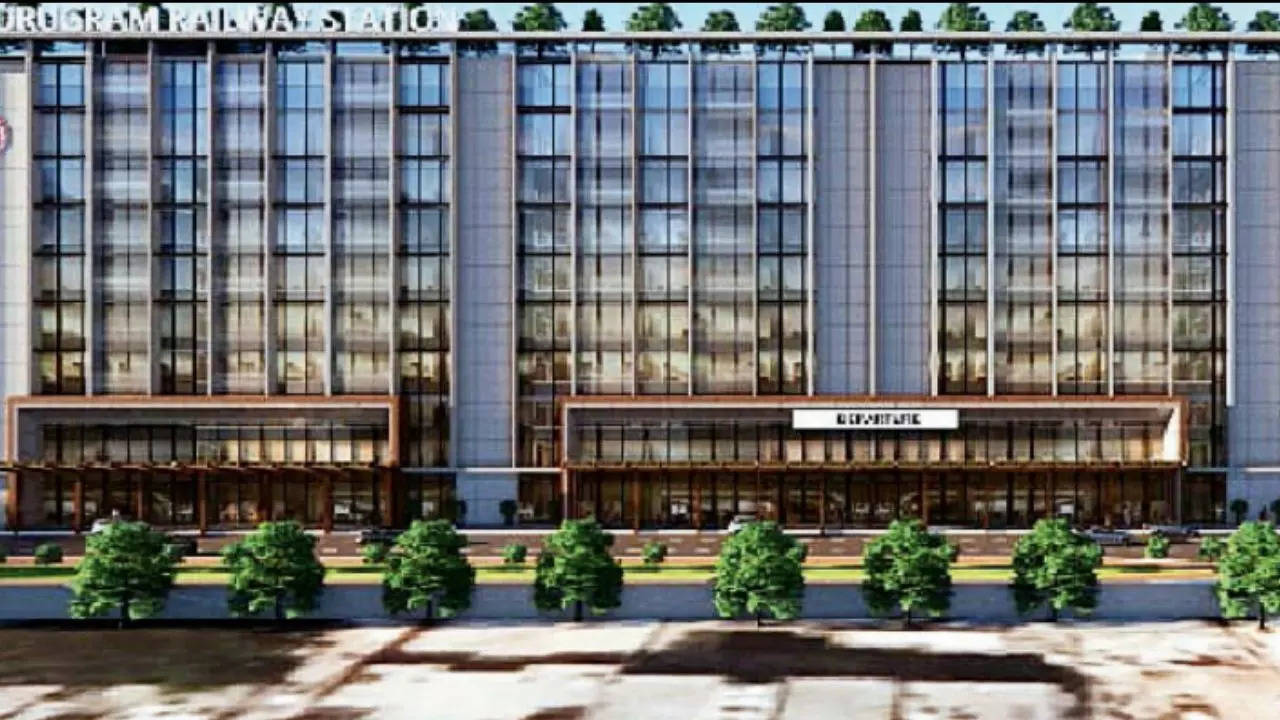GURGAON: Prime Minister Narendra Modi on Monday virtually laid the foundation for the redevelopment of Gurgaon railway station. Across the country, the PM launched the revamp work of 554 railway stations and 1,500 overbridges and underpasses.
As part of the Gurgaon project, the station area will be expanded by more than 15 times — from 1,500sqm to 23,587sqm — over the next three year. The main terminal will be nine-storey high, with not just railway offices but food courts and lounges too. The revamped station will have a multilevel parking and a concourse.
The new station will have a fourth platform and multiple entries and exits so that the approach road can be decongested. As of now, the railway station has just one entry.
Union minister and local MP Rao Inderjeet Singh, who was at the station when the PM laid the foundation, said the revamp project would cost Rs 300 crore. “The railway ministry is carrying out projects worth Rs 20,000 crore across the state. New stations are being built and existing ones are being revamped. All these are being done for the convenience of passengers,” he added.
“The redeveloped Gurgaon station will have several world-class facilities. For instance, a roof plaza will connect to the platforms,” Singh said.
Of the nine floors in the main building, three will house offices of the railways. One will be set aside exclusively for passengers, with a huge waiting area, a lounge and other facilities. There will be a floor with food courts and other eateries. The remaining storeys will have commercial establishments and showrooms.
Keeping in mind the rise in passenger traffic, the authorities will build a multilevel parking too — stilt plus four floors.
Built in 1950, the Gurgaon station hasn’t seen much development over the years, mostly because of the lack of passenger traffic. The station, for instance, spans only 1,530sqm, with just one gate for entry and exit on the Old Gurgaon Road side.
Industrialists agreed that the redevelopment of the railway station would have a ripple effect on Old Gurgaon and areas around it.
“Improved railway amenities will facilitate seamless transportation, spurring economic growth and creating opportunities around the region. Additionally, shops and other commercial establishments at the station will only amplify the appearance. Once hi-tech trains ply on the stretch, it will enhance the overall lifestyle and offer a better living experience around the ecosystem,” said Santosh Agarwal, executive director and CFO at Alphacorp.
Pradeep Aggarwal, the founder and chairperson of Signature Global (India), dubbed the move a “pivotal moment for urban infrastructure”.
“This development is not just about the railway station. It’s a reflection of the evolving urban landscape, setting the stage for comprehensive urban planning and development. As the Gurgaon railway station undergoes this transformation, we foresee a positive ripple effect,” Aggarwal said.
Ankush Kaul, the chief business officer at Ambience Group, said, “The transformation of the station into a state-of-the-art facility with multiple entry points and innovative amenities reflects the city’s progress path. Moreover, the introduction of direct access to the station will further enhance connectivity in the city.”
As part of the Gurgaon project, the station area will be expanded by more than 15 times — from 1,500sqm to 23,587sqm — over the next three year. The main terminal will be nine-storey high, with not just railway offices but food courts and lounges too. The revamped station will have a multilevel parking and a concourse.
The new station will have a fourth platform and multiple entries and exits so that the approach road can be decongested. As of now, the railway station has just one entry.
Union minister and local MP Rao Inderjeet Singh, who was at the station when the PM laid the foundation, said the revamp project would cost Rs 300 crore. “The railway ministry is carrying out projects worth Rs 20,000 crore across the state. New stations are being built and existing ones are being revamped. All these are being done for the convenience of passengers,” he added.
“The redeveloped Gurgaon station will have several world-class facilities. For instance, a roof plaza will connect to the platforms,” Singh said.
Of the nine floors in the main building, three will house offices of the railways. One will be set aside exclusively for passengers, with a huge waiting area, a lounge and other facilities. There will be a floor with food courts and other eateries. The remaining storeys will have commercial establishments and showrooms.
Keeping in mind the rise in passenger traffic, the authorities will build a multilevel parking too — stilt plus four floors.
Built in 1950, the Gurgaon station hasn’t seen much development over the years, mostly because of the lack of passenger traffic. The station, for instance, spans only 1,530sqm, with just one gate for entry and exit on the Old Gurgaon Road side.
Industrialists agreed that the redevelopment of the railway station would have a ripple effect on Old Gurgaon and areas around it.
“Improved railway amenities will facilitate seamless transportation, spurring economic growth and creating opportunities around the region. Additionally, shops and other commercial establishments at the station will only amplify the appearance. Once hi-tech trains ply on the stretch, it will enhance the overall lifestyle and offer a better living experience around the ecosystem,” said Santosh Agarwal, executive director and CFO at Alphacorp.
Pradeep Aggarwal, the founder and chairperson of Signature Global (India), dubbed the move a “pivotal moment for urban infrastructure”.
“This development is not just about the railway station. It’s a reflection of the evolving urban landscape, setting the stage for comprehensive urban planning and development. As the Gurgaon railway station undergoes this transformation, we foresee a positive ripple effect,” Aggarwal said.
Ankush Kaul, the chief business officer at Ambience Group, said, “The transformation of the station into a state-of-the-art facility with multiple entry points and innovative amenities reflects the city’s progress path. Moreover, the introduction of direct access to the station will further enhance connectivity in the city.”
